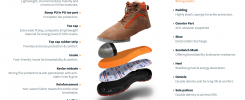When people think of workplace safety they often focus on hazards that are life threatening, or those that can cause a serious disability. Of course, these are extremely important and need to be taken seriously, however, it is also important to take steps to provide head to toe protection for employees. Specifically, foot protection is an important concern that often goes overlooked.
People don’t often think about their feet, and keeping them safe, until after they are injured. A foot injury, however, can be extremely painful and debilitating. Most people don’t realize just how much they are on their feet, until they experience this type of injury. With this in mind, facility safety managers need to make sure foot protection is a priority throughout the facility. There are many different things that can be done to keep the feet safe, and each facility will need to come up with an effective plan of action.
Table of Contents
Potential Foot Hazards
According to an Occupational Health and Safety article on Footwear,
There are two major categories of foot injuries: those caused by punctures, crushing, sprains, and lacerations; and those that result from slips, trips, and falls.
-OHS – Footwear in Focus

When thinking about foot protection the first thing most safety managers will think of is protecting feet from things being dropped on them. This makes sense because that is one of the most common types of foot injury. Dropping heavy items that are being carried or moved can quickly crush a foot, resulting in serious breaks or bruises. That is really just the beginning, however. Look at this list of potential risks to people’s feet in any given facility.
- Electrocution – Most extension cords and many other electrical sources are run along the ground. In ideal situations the cords will be protected and so will the feet, but that is not always the case. Kicking a cord on accident can cause electrocution or shocks, which can result in very serious injuries.
- Chemicals and Solvents – If a chemical is dropped or spilled, it can quickly soak through most shoes and socks, resulting in severe burns. Even if the spill is well away from the employee when it happens, it can spread quickly and silently, resulting in unsuspecting employees being put at risk.
- Frostbite – When working outside, or in a freezer area, the feet are often one of the first parts of the body to get cold. Unfortunately, they often lose sensitivity more quickly than other parts of the body, leaving them susceptible to frostbite or other cold related tissue damage. In extremely cold temperatures, this can happen more quickly than most people would believe. The risk is even more significant when the feet get wet and cold.
- Slips & Falls – While the risk affects the entire body, slips and falls often start at the feet.
- Drops – Of course, dropping heavy items on your feet is a big risk. It takes just fractions of a second to drop something on your foot, resulting in significant injury.
Foot Protection
Each of the above mentioned risks to the feet should be taken very seriously. Safety managers can, however, provide proper foot protection to the employees in order to reduce or eliminate the risks. The following points are solutions to the risks listed above:
- Electrical Hazard Protective Sole – The sole and heel of shoes can be constructed in a way that reduces the chances of electricity from coming in contact with the foot.
- Chemical Resistant Shoes – Choosing shoes made from leather or a synthetic material that is resistant to chemicals and solvents is a great idea. This could be made from rubber, vinyl, plastic, PVC or some other compound. Depending on the work environment, choosing footwear that covers the foot, and part of the leg may be a good idea.
- Insulated Footwear – To keep your feet safe from the cold, choose insulated footwear. You can combine this with insulated socks as well. Encouraging employees to come in from the cold and check on the health of their feet is another great way to ensure everyone is practicing proper foot protection strategies.
- High Traction Shoes – Choosing footwear that is designed for the type of work environment people will be in is a good idea. If working in areas where there are often wet floors, for example, choosing a shoe with high traction can be a good idea. In icy areas, snow boots may be the right choice.
- Steel Toe Shoes and Boots – Keeping your feet protected from things dropping on them is often done with steel toed boots. These boots have a very strong toe, which will protect your feet if something smashes onto them. There are many different types of these boots to choose from, and finding the ones that work best in your facility is very important.
Prevention is Key to Foot Safety
While preventing special protective footwear is a good way to keep everyone’s feet safe, it really isn’t enough. Having employees actively work to prevent any sort of accident or other risk to their feet is a good idea. This can be done through facility training (using safety training DVD’s such as this) in many cases. Showing employees what types of risks exist in the facility, for example, is a good start. Then showing everyone how those risks can be avoided or minimized. This way, even if they have the protective footwear, they will be even safer.
If people are often carrying heavy objects, make sure they have moving carts or other tools that will help ensure the move is able to be completed safety. In addition to protecting people’s feet from drops, it will also protect their backs from getting trained. When you focus on foot protection, you’re actually protecting the entire body.
